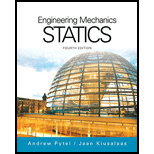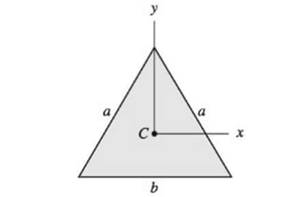
International Edition---engineering Mechanics: Statics, 4th Edition
4th Edition
ISBN: 9781305501607
Author: Andrew Pytel And Jaan Kiusalaas
Publisher: CENGAGE L
expand_more
expand_more
format_list_bulleted
Concept explainers
Textbook Question
Chapter 9, Problem 9.28P
Determine the ratio a/b for which

Expert Solution & Answer
Trending nowThis is a popular solution!

Students have asked these similar questions
using the theorem of three moments, find all the moments, I need concise calculations only
Practise question need help on
Can you show explaination and working. The answer from the text book is Q=5.03 X 10^-3
Chapter 9 Solutions
International Edition---engineering Mechanics: Statics, 4th Edition
Ch. 9 - Compute the moment of inertia of the shaded region...Ch. 9 - The properties of the plane region are...Ch. 9 - The moments of inertia of the plane region about...Ch. 9 - The moment of inertia of the plane region about...Ch. 9 - Using integration, find the moment of inertia and...Ch. 9 - Use integration to determine the moment of inertia...Ch. 9 - Determine Ix and Iy for the plane region using...Ch. 9 - Using integration, compute the polar moment of...Ch. 9 - Use integration to compute Ix and Iy for the...Ch. 9 - By integration, determine the moments of inertia...
Ch. 9 - Compute the moment of inertia about the x-axis for...Ch. 9 - By integration, find the moment of inertia about...Ch. 9 - Figure (a) shows the cross section of a column...Ch. 9 - Compute the dimensions of the rectangle shown in...Ch. 9 - Compute Ix and Iy for the W867 shape dimensioned...Ch. 9 - Figure (a) shows the cross-sectional dimensions...Ch. 9 - A W867 section is joined to a C1020 section to...Ch. 9 - Compute Ix and Iy for the region shown.Ch. 9 - Prob. 9.19PCh. 9 - Calculate Ix for the shaded region, knowing that...Ch. 9 - Compute Iy for the region shown, given that...Ch. 9 - Prob. 9.22PCh. 9 - Prob. 9.23PCh. 9 - Determine Ix for the triangular region shown.Ch. 9 - Determine the distance h for which the moment of...Ch. 9 - A circular region of radius R/2 is cut out from...Ch. 9 - Prob. 9.27PCh. 9 - Determine the ratio a/b for which Ix=Iy for the...Ch. 9 - As a round log passes through a sawmill, two slabs...Ch. 9 - Prob. 9.30PCh. 9 - By numerical integration, compute the moments of...Ch. 9 - Use numerical integration to compute the moments...Ch. 9 - The plane region A is submerged in a fluid of...Ch. 9 - Use integration to verify the formula given in...Ch. 9 - For the quarter circle in Table 9.2, verify the...Ch. 9 - Determine the product of inertia with respect to...Ch. 9 - The product of inertia of triangle (a) with...Ch. 9 - Prob. 9.38PCh. 9 - For the region shown, Ixy=320103mm4 and Iuv=0....Ch. 9 - Prob. 9.40PCh. 9 - Calculate the product of inertia with respect to...Ch. 9 - Prob. 9.42PCh. 9 - Prob. 9.43PCh. 9 - The figure shows the cross section of a standard...Ch. 9 - Prob. 9.45PCh. 9 - Prob. 9.46PCh. 9 - Prob. 9.47PCh. 9 - Use numerical integration to compute the product...Ch. 9 - Determine the dimension b of the square cutout so...Ch. 9 - For the rectangular region, determine (a) the...Ch. 9 - Prob. 9.51PCh. 9 - Prob. 9.52PCh. 9 - Prob. 9.53PCh. 9 - Prob. 9.54PCh. 9 - Prob. 9.55PCh. 9 - The u- and v-axes are the principal axes of the...Ch. 9 - The x- and y-axes are the principal axes for the...Ch. 9 - Prob. 9.58PCh. 9 - The inertial properties of the region shown with...Ch. 9 - Determine Iu for the inverted T-section shown....Ch. 9 - Using Ix and Iu from Table 9.2, determine the...Ch. 9 - Show that every axis passing through the centroid...Ch. 9 - Prob. 9.63PCh. 9 - The L806010-mm structural angle has the following...Ch. 9 - Compute the principal centroidal moments of...Ch. 9 - Prob. 9.66PCh. 9 - Determine the principal axes and the principal...Ch. 9 - Compute the principal centroidal moments of...Ch. 9 - Find the moments and the product of inertia of the...Ch. 9 - Determine the moments and product of inertia of...Ch. 9 - Find the principal moments of inertia and the...Ch. 9 - Determine the moments and product of inertia of...Ch. 9 - Prob. 9.73PCh. 9 - Prob. 9.74PCh. 9 - The u- and v-axes are the principal axes of the...Ch. 9 - The x- and y-axes are the principal axes for the...Ch. 9 - Prob. 9.77PCh. 9 - The L806010-mm structural angle has the following...Ch. 9 - Prob. 9.79RPCh. 9 - Prob. 9.80RPCh. 9 - By integration, show that the product of inertia...Ch. 9 - Compute Ix and Iy for the shaded region.Ch. 9 - Using integration, evaluate the moments of inertia...Ch. 9 - The inertial properties at point 0 for a plane...Ch. 9 - Compute Ix and Iy for the shaded region.Ch. 9 - The flanged bolt coupling is fabricated by...Ch. 9 - Prob. 9.87RPCh. 9 - Compute Ix,Iy, and Ixy for the shaded region.Ch. 9 - Determine Ix and Ixy for the shaded region shown.Ch. 9 - Calculate Ix,Iy, and Ixy for the shaded region...Ch. 9 - For the shaded region shown, determine (a) Ix and...Ch. 9 - Use integration to find Ix,Iy, and Ixy for the...Ch. 9 - Determine the principal moments of inertia and the...Ch. 9 - The properties of the unequal angle section are...
Knowledge Booster
Learn more about
Need a deep-dive on the concept behind this application? Look no further. Learn more about this topic, mechanical-engineering and related others by exploring similar questions and additional content below.Similar questions
- practise questionarrow_forwardCan you provide steps and an explaination on how the height value to calculate the Pressure at point B is (-5-3.5) and the solution is 86.4kPa.arrow_forwardPROBLEM 3.46 The solid cylindrical rod BC of length L = 600 mm is attached to the rigid lever AB of length a = 380 mm and to the support at C. When a 500 N force P is applied at A, design specifications require that the displacement of A not exceed 25 mm when a 500 N force P is applied at A For the material indicated determine the required diameter of the rod. Aluminium: Tall = 65 MPa, G = 27 GPa. Aarrow_forward
- Find the equivalent mass of the rocker arm assembly with respect to the x coordinate. k₁ mi m2 k₁arrow_forward2. Figure below shows a U-tube manometer open at both ends and containing a column of liquid mercury of length l and specific weight y. Considering a small displacement x of the manometer meniscus from its equilibrium position (or datum), determine the equivalent spring constant associated with the restoring force. Datum Area, Aarrow_forward1. The consequences of a head-on collision of two automobiles can be studied by considering the impact of the automobile on a barrier, as shown in figure below. Construct a mathematical model (i.e., draw the diagram) by considering the masses of the automobile body, engine, transmission, and suspension and the elasticity of the bumpers, radiator, sheet metal body, driveline, and engine mounts.arrow_forward
- 3.) 15.40 – Collar B moves up at constant velocity vB = 1.5 m/s. Rod AB has length = 1.2 m. The incline is at angle = 25°. Compute an expression for the angular velocity of rod AB, ė and the velocity of end A of the rod (✓✓) as a function of v₂,1,0,0. Then compute numerical answers for ȧ & y_ with 0 = 50°.arrow_forward2.) 15.12 The assembly shown consists of the straight rod ABC which passes through and is welded to the grectangular plate DEFH. The assembly rotates about the axis AC with a constant angular velocity of 9 rad/s. Knowing that the motion when viewed from C is counterclockwise, determine the velocity and acceleration of corner F.arrow_forward500 Q3: The attachment shown in Fig.3 is made of 1040 HR. The static force is 30 kN. Specify the weldment (give the pattern, electrode number, type of weld, length of weld, and leg size). Fig. 3 All dimension in mm 30 kN 100 (10 Marks)arrow_forward
- (read image) (answer given)arrow_forwardA cylinder and a disk are used as pulleys, as shown in the figure. Using the data given in the figure, if a body of mass m = 3 kg is released from rest after falling a height h 1.5 m, find: a) The velocity of the body. b) The angular velocity of the disk. c) The number of revolutions the cylinder has made. T₁ F Rd = 0.2 m md = 2 kg T T₂1 Rc = 0.4 m mc = 5 kg ☐ m = 3 kgarrow_forward(read image) (answer given)arrow_forward
arrow_back_ios
SEE MORE QUESTIONS
arrow_forward_ios
Recommended textbooks for you
 International Edition---engineering Mechanics: St...Mechanical EngineeringISBN:9781305501607Author:Andrew Pytel And Jaan KiusalaasPublisher:CENGAGE L
International Edition---engineering Mechanics: St...Mechanical EngineeringISBN:9781305501607Author:Andrew Pytel And Jaan KiusalaasPublisher:CENGAGE L

International Edition---engineering Mechanics: St...
Mechanical Engineering
ISBN:9781305501607
Author:Andrew Pytel And Jaan Kiusalaas
Publisher:CENGAGE L
Force | Free Body Diagrams | Physics | Don't Memorise; Author: Don't Memorise;https://www.youtube.com/watch?v=4Bwwq1munB0;License: Standard YouTube License, CC-BY